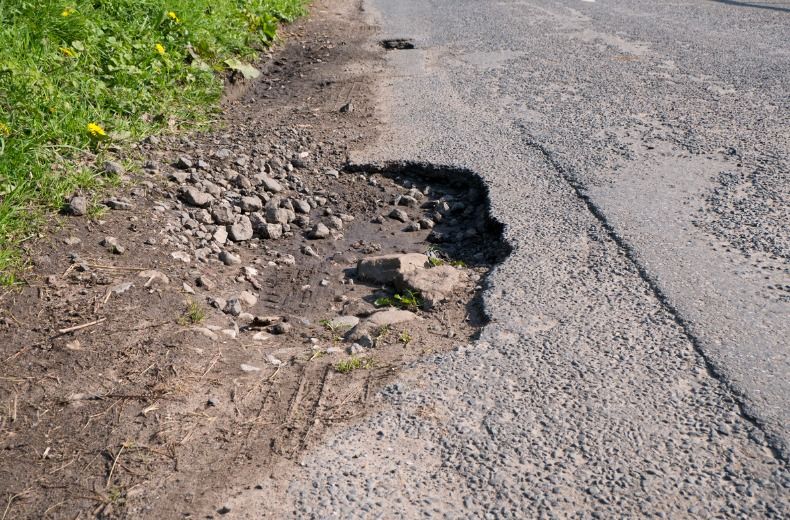Since the start of 2023, the RAC has dealt with 18,250 breakdowns for damaged shock absorbers, broken suspension springs or distorted wheels – the call-outs which are most likely caused by defective road surfaces.
The 8,100 pothole-related breakdowns recorded in Q2 is the highest the RAC has since the ‘Beast from the East’ cold snap plunged much of the UK into a deep freeze with heavy snowfall five years ago.
The figures show that 27,250 breakdowns occurred in the 12 months up to 30 June 2023 where vehicles had been damaged by a pothole, compared to 22,800 over the same period in 2022 – 20% increase more than last year (4,550 more breakdowns).
The RAC Pothole Index, which tracks pothole call-outs since 2006 seasonally adjusted for weather, reveals drivers are now over 1.6 times more likely to break down due to the repeated wear caused by potholes than they were 17 years ago.
This does not include punctures as other factors such as nails and screws may also be to blame. However, the number of punctured tyres RAC patrols went out to in the second quarter of 2023 (101,200) was 13% higher than the previous year (89,600), indicating that poor road surfaces may well have played a part.
A Freedom of Information request made by the RAC* also reveals councils have forked out more than £11m over the last four years to drivers who successfully claimed their vehicles had been damaged by potholes.
Data provided by the 172 councils (of the 208 across the UK with responsibility for highways) that responded shows £2.41m was paid to drivers in 2020/21, £2.71m in 2019/20 and £3.61m in 2018/19 – meaning the collective compensation paid by these councils fell by a third (33%) from 2018/19 to 2021/22.
The RAC also asked councils to detail how much they spend on maintaining their roads over the same three years. The findings show that, among the councils that supplied data, almost £1bn** was allocated with a further £3.5bn*** spent on carriageway resurfacing.
Interestingly, the amount councils spent on routine maintenance per year rose by 17% between 2018/19 (£237m) and 2021/22 (£277m)**, though the effect of inflation on material and labour costs may well mean this increase have drastically improved road quality. Meanwhile, the amount spent on planned resurfacing went up by 9% between 2018/19 (£851m) and 2021/22 (£928m)***.
RAC head of roads policy Nicholas Lyes said: “Drivers won’t be surprised to hear pothole-related breakdowns are at their highest level for five years due to several spells of well below-average temperatures interspersed with some very wet conditions last winter. These conditions led to water getting into cracks, freezing and expanding which caused road surfaces to deteriorate rapidly as vehicles drove over them. But despite these perfect pothole-forming conditions, it’s also important to note that last winter wasn’t particularly harsh which demonstrates very clearly just how fragile our local roads really are.
“The fact councils are paying out money to drivers whose vehicles suffered pothole damage is another damning indictment of the state of our roads. In an ideal world where roads are in a fit-for-purpose state they wouldn’t need to be doing this at all.
“One crumb of comfort for councils is that in recent years the amount they have paid out has fallen considerably which might indicate that they are starting to get on top of defective road surfaces more quickly. Conversely, it could mean drivers are reporting fewer potholes to the council which is significant because if councils are unaware of a defective road surface, then they are not obligated to pay out for vehicle repairs.
“While spending on our local roads appears to be heading in the right direction, councils are facing a toxic combination of higher material costs, higher contractor and labour costs and a cold and wet recent winter. It may well be the case that even with more money being spent on the roads, much of this will be getting eaten up by inflationary pressures. All of this adds weight to the argument that councils should invest more in innovative machinery that can fix potholes as quickly and permanently as possible.
“Of course, the elephant in the room is the amount of money available, which is why we continue to call on the Government to ringfence 2p from every litre of existing fuel revenues over a five-year period which will give councils the certainty of funding they need to be able to plan proper maintenance programmes.”


RAC sale – up to 33% off*
• Roadside cover from £5.29 a month†
• We get to most breakdowns in 60 mins or less
• Our patrols fix 4/5 breakdowns on the spot

1 Based on a Freedom of Information request to councils in December 2022. The question asked to each authority was “How much was paid out (in £) to drivers making a claim for damage caused to their vehicles due to defective road surface/potholes?” in 2018/19, 2019/20, 2020/21, 2021/22.
2 Based on a Freedom of Information request to councils in December 2022. Question asked: “Please state how much was spent on repairing defective road surface/potholes (roads only, not pavements) in 2018/19, 2019/20, 2020/21 and 2021/22?”.
3 Based on a Freedom of Information request to councils in December 2022. Question asked: “2. Please state how much was spent on carriageway resurfacing in 2018/19, 2019/20, 2020/21 and 2021/22?”.









